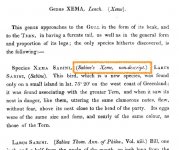Jawaharlal Merlin Roth-Re
Member

Does anyone know the translation of Xema I know the genus name of the Sabine's gull is Xema



Mark, I'm not sure I understand what you're looking for, and "disagree a little with" ... ?Björn thank you for the link to the Key which is awesome. But I disagree a little with it about Xema. Leach did not call the bird Sabine's Xeme. He made a Latin genus name out of a bird John Ross gave the common/English name of Xeme. ...
XEMA
(Laridae; Ϯ Sabine's Gull X. sabini) Coined from substantive name “Sabine’s Xeme” given to Sabine’s Gull by Leach 1819. Brookes 1828, has ...
[...]
"Genus XEMA. Leach (Xeme). THIS genus approaches to the GULL in the form of its beak, and to the TERN in having a furcate tail as well as in the general form and proportion of its legs; the only species hitherto discovered is the following: — Species XEMA SABINI, (Sabine's Xeme, non-descript) LARUS SABINI (Sabine)." (Leach 1819); "Xema Leach, in Ross' Voy. Disc., 1819, app. 2, p. lvii. Type, by monotypy, Larus sabini J. Sabine." (Peters, 1934, II, p. 326).
[...]

Isn't Appendix, No. II (Zoological Memoranda), in Ross's A Voyage of Discovery, (vol II, 1819) simply written by Dr Leach... ?

But in the Octavo 8vo version of the Voyage of Discovery (still in 1819) Leach claims that Larus collaris by Schreibers was published first that in fact Sabine’s Xene was not a non-descript. It was described prior to 1818. He calls it Collared Xeme with not calling it non-descript.

